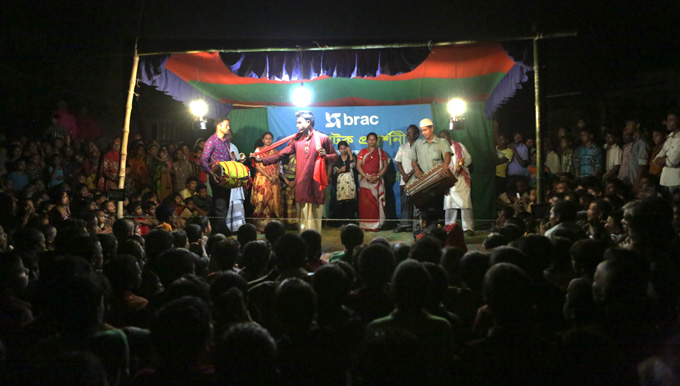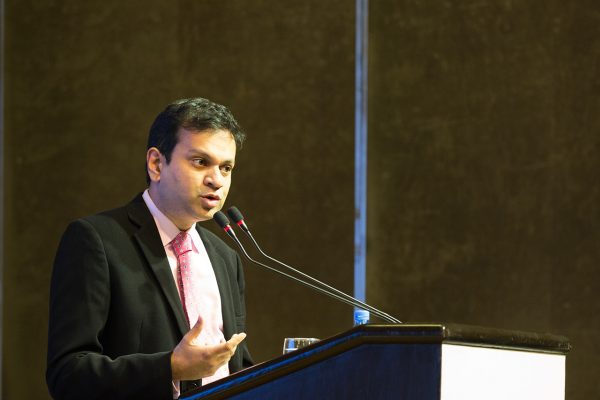Reading Time: 3 minutes
As dusk falls in the small town of Pachargali, Rangpur, dozens of lanterns blink to life, marking a clearing surrounded by corn and paddy fields. A crowd gathers around a makeshift stage. BRAC’s popular theatre is back in town, a much awaited event for this village.
A hush fell as a man in a yellow punjabi took to the stage beating a dhol (drum), singing of a girl named Banu.
The play is titled Mukti Chai, translating to ‘I want freedom’. It depicts the feisty 15-year-old Banu whose wedding ceremony is stopped when the sensible ward commissioner comes to her rescue, in the end, drawing affirmation from the audience about the criminality of the act.
Sweety Akhter, who plays Banu, appears just as spirited in person. Her grandfather, Nazrul Islam is also an actor in the play and has been with BRAC’s popular theatre group since its birth. Sweety has shared the same experience as the character she plays. Her parents had arranged her marriage when she was 13. It was her grandfather, Nazrul himself, who stopped it, later taking her under his wing and training her in acting. Together, the duo creates magic on stage as they travel and perform across villages in northern Bangladesh. Rustic tunes accompanied by dhol and ak tara (one-stringed folk instrument) provides the backdrop of the tragicomic scenes.
Popular theatre – theatre using participatory approaches – began as a tool in the international development community during the 1960s and 1970s. It was concerned with the belief that change can be achieved by giving power over to the communities – members of communities will engage with the larger community though theatrical performances designed towards sparking behaviourial changes.
There are several models of popular theatre used around the world, some collaborating with local theatre groups while others hiring full-time theatre staff. When BRAC began popular theatre in 1998, it decided the best way to reach rural communities was to engage with those from within the communities itself. The performers are local folk artists, teachers, students and housewives – optimists who dreams of better societies.
Anna Minj, director of BRAC’s community empowerment programme points out, “What sets BRAC’s popular theatre apart from other organisations in Bangladesh is that it involves grassroots communities who package and perform drama in local dialects, based on real cases. Our performers are from the local community, including folk talents who work with us as volunteers. Through the programme, they emerge as change agents in their communities.”
Our popular theatres continue the age-old tradition of storytelling in rural Bengal. The world’s largest village theatre network, it draws over 4 million women, men and children into its audience every year.
Interactivity between the audience and actors during the play is followed by discussions. The dialogue is often reiterated by members of polli shomaj, BRAC’s network of women-led grassroots committees. This is where the true impact of popular theatre is felt. BRAC’s participatory approach in all of its 369 theatre groups across Bangladesh are intended to give communities a sense of ownership.
A recent research by BRAC’s research and evaluation division confirms that the audience begins to engage in emotional and intellectual dialogue among themselves. It was found that changes that bring immediate reward and do not have deeper social factors seem to be easier to achieve. Take for instance, the use of oral saline or drinking clean water. However, poblems deeply embedded in the social structure, the practice of dowry for example, are difficult to overturn, and is where BRAC faces challenges. On the other hand, presenting complex problems in comprehensible language ensures people’s participation, something that the popular theatre strives to do.
All of BRAC’s development programmes use popular theatre as a tool to generate dialogue, touching on issues from hygiene to domestic violence to land disputes. It empowers ordinary people like Sweety and Nazrul to use their artistic talent and fuel change in their communities. Their voices resound with hope and passion, about gender equality and social justice.
Sameeha Suraiya is a content strategist at BRAC Communications.






